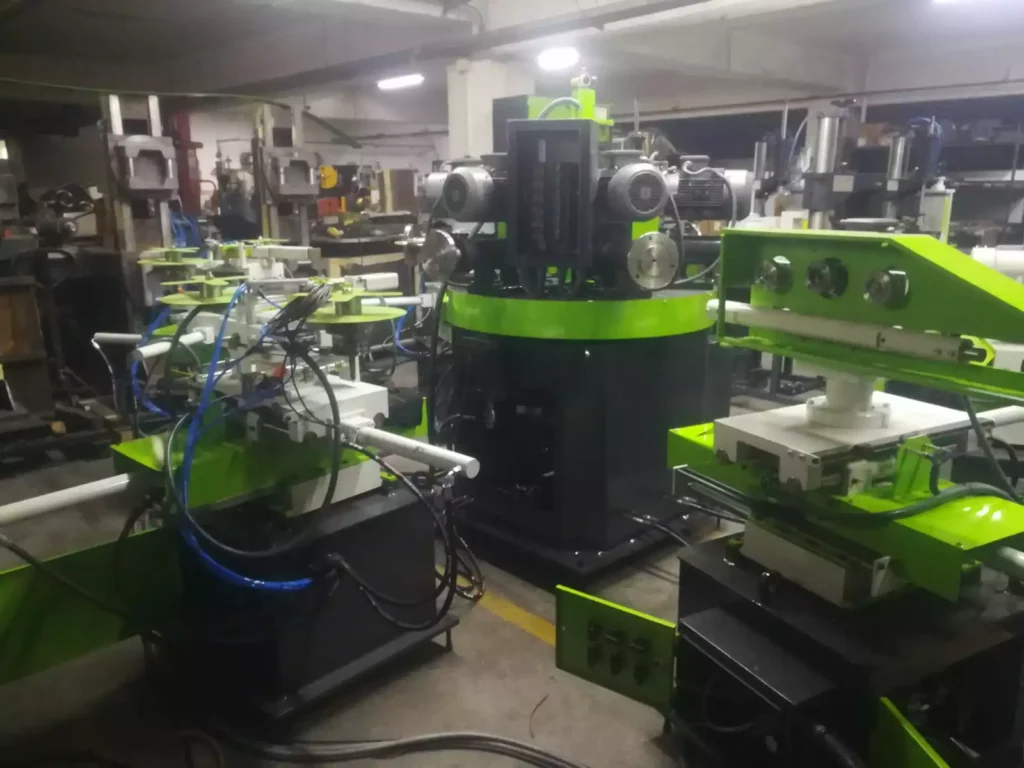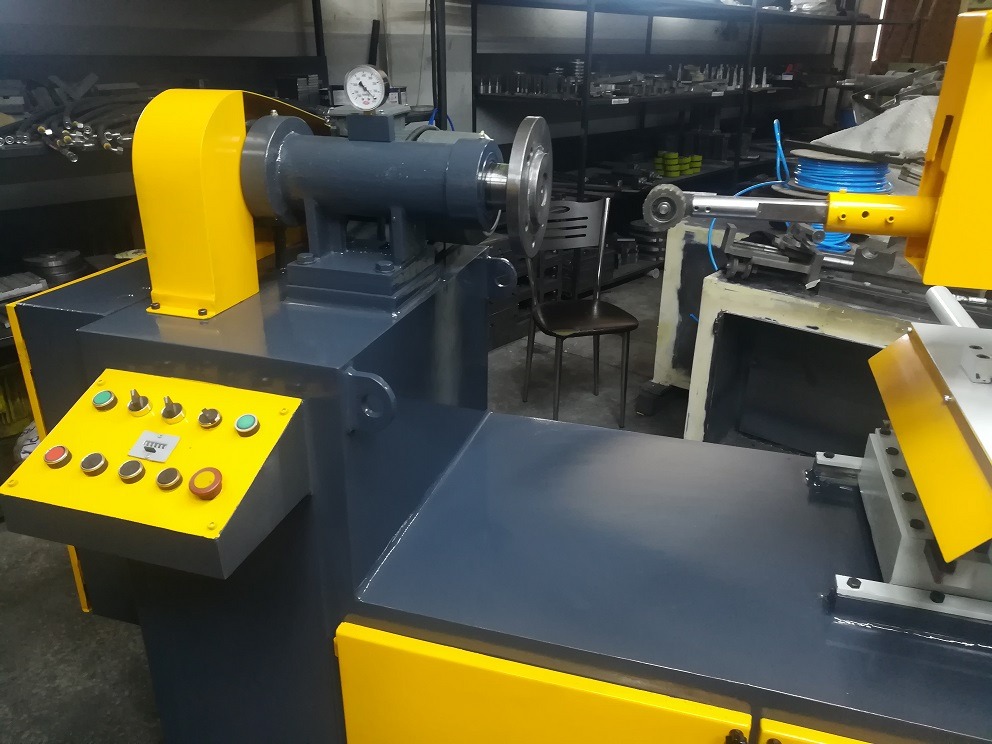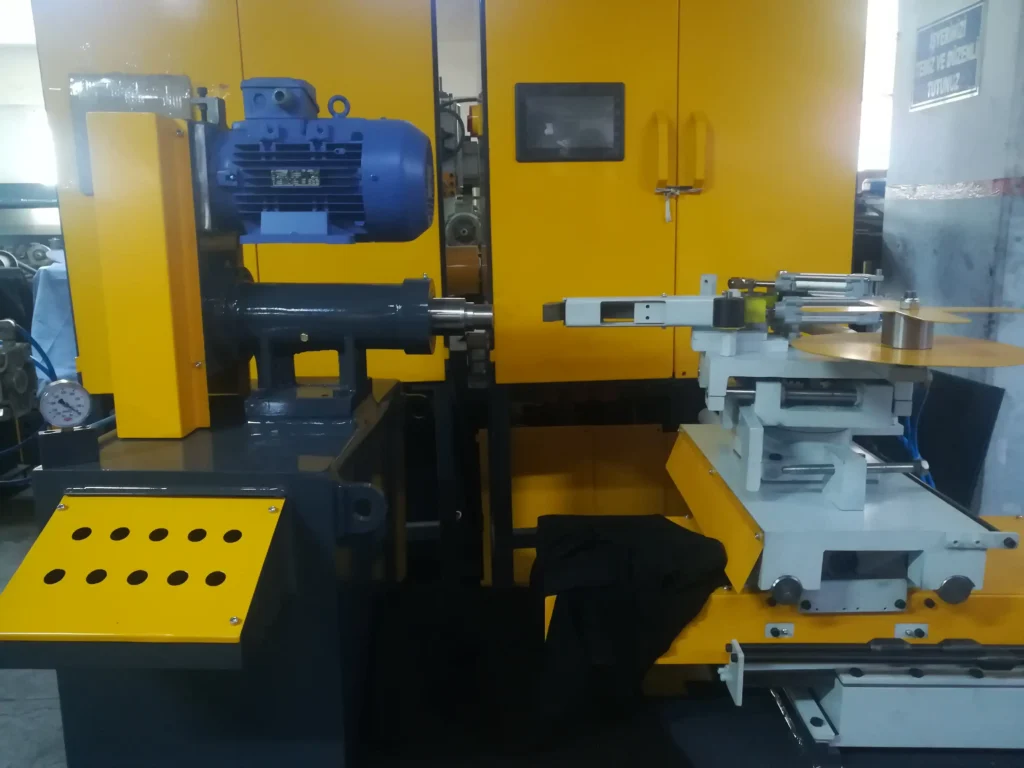
A polishing machine for internal polishing of cookware or kitchenware such as pots and pans made from stainless steel is applicated after the circle blanks are manufactured by a hydraulic deep drawing press. This hydraulic press draws the pot or pan from a circular metal sheet and operators usually apply adhesives to make the surface slip during the deep-drawing operation. Otherwise, the sheet metal may tear easily.
A polishing machine for internal polishing of stainless steel pots typically works by using rotating polishing heads and specialized polishing compounds to achieve a smooth and shiny surface finish on the inside of the pot. Here are the general steps involved in the process:
- Load the pot onto the machine’s chuck or fixture.
- Start the machine and adjust the speed and pressure settings according to the pot’s size and the desired surface finish.
- The polishing head moves inside the pot, applying polishing compounds to the surface.
- The rotating spindles of the polishing head polish the inside of the pot as it rotates on the chuck.
- Once the internal polishing is complete, the machine automatically stops and the polished pot is unloaded.
The specific details of how the machine works can vary depending on the model and manufacturer, but the general idea is that the machine automates the internal polishing process, providing consistent results with less manual labor and effort. Some machines may also have specialized features such as automated compound application and cleaning systems to further streamline the process.
The polishing compounds used in the machine are typically abrasive pastes or liquids that are formulated to remove imperfections and scratches from the surface of the stainless steel. They may contain a variety of ingredients such as alumina, silicon carbide, or diamond powder, depending on the level of abrasiveness required for the job.
The polishing heads themselves can come in different shapes and sizes, depending on the type of pot being polished and the specific areas of the pot that need attention. Some machines have multiple heads that can work on different parts of the pot simultaneously.
In addition to internal polishing, some machines may also be capable of polishing the exterior of the pot or other types of cookware. These machines may have different types of polishing heads or fixtures to accommodate the different shapes and sizes of cookware.
Overall, a polishing machine for internal polishing of stainless steel pots can provide an efficient and effective way to achieve a consistent and high-quality surface finish on the inside of cookware, helping manufacturers to produce products that are attractive and functional.
Polishing Machine for Internal Polishing of Stainless Steel Pots
Polishing machines for internal polishing of stainless steel pots are essential tools in the cookware manufacturing industry, producing pots with a smooth, shiny, and hygienic interior surface. These machines typically employ vibratory tumbling or centrifugal polishing techniques to remove imperfections, tarnish, and roughness from the inner walls of pots.
Operating Principle of Polishing Machines for Internal Polishing of Stainless Steel Pots
- Vibratory Tumbling Machines: In vibratory tumbling machines, the pots are placed in a rotating chamber along with abrasive media, such as ceramic beads or stainless steel balls. As the chamber vibrates, the abrasive media tumbles and rubs against the pots, removing imperfections and polishing the interior surface.
- Centrifugal Polishing Machines: Centrifugal polishing machines utilize centrifugal force to press the pots against abrasive media. The pots are placed in a rotating basket with abrasive media. As the basket rotates at high speed, the centrifugal force presses the pots against the abrasive media, effectively polishing the interior surface.
Key Components of Polishing Machines for Internal Polishing of Stainless Steel Pots
- Rotating Chamber or Basket: The rotating chamber or basket holds the pots and abrasive media during the polishing process. It ensures that the pots are evenly exposed to the abrasive media.
- Abrasive Media Dispensing System: The abrasive media dispensing system controls the flow and quantity of abrasive media used during the polishing process. This system ensures consistent polishing results.
- Water Inlet and Outlet: The water inlet allows for the introduction of water into the chamber, which helps to lubricate the abrasive media, prevent overheating, and remove debris generated during the polishing process. The water outlet allows for the discharge of dirty water.
- Control Panel: The control panel houses various controls for operating the machine, including start/stop buttons, vibration intensity adjustment, timer settings, and water flow control.
Rotating Chamber or Basket

The Rotating Chamber or Basket of the Polishing Machine for Internal Polishing of Stainless Steel Pots
The rotating chamber or basket is the heart of the polishing machine for internal polishing of stainless steel pots. It is the component that holds the pots and abrasive media during the polishing process, ensuring that the pots are evenly exposed to the abrasive media and effectively polished on all sides.
Design and Construction
The rotating chamber or basket is typically made of durable materials that can withstand the rigors of the polishing process. Stainless steel is a common choice due to its resistance to corrosion and abrasion. The shape of the chamber or basket is designed to ensure efficient tumbling of the pots and abrasive media. For vibratory tumbling machines, the chamber may have a cylindrical or oval shape, while centrifugal polishing machines often use baskets with a more open design to allow for better airflow.
Rotation Mechanism
The rotation mechanism is responsible for driving the movement of the chamber or basket, which in turn causes the abrasive media to tumble and polish the pots. Vibratory tumbling machines typically employ an eccentric weight or a series of springs to create a vibrating motion, while centrifugal polishing machines utilize a high-speed motor to achieve rapid rotation.
Abrasive Media Interaction
The rotating chamber or basket ensures that the pots are constantly interacting with the abrasive media, allowing for effective polishing of the interior surfaces. The tumbling motion in vibratory tumbling machines promotes consistent contact between the pots and the abrasive media, while the centrifugal force in centrifugal polishing machines presses the pots against the abrasive media, enhancing the polishing action.
Role in Polishing Process
The rotating chamber or basket plays a crucial role in achieving a uniform and consistent polish across all pots. It ensures that each pot is exposed to the abrasive media for the same duration and with the same intensity, preventing any areas from being over-polished or under-polished.
Maintenance and Cleaning
Regular maintenance and cleaning of the rotating chamber or basket are essential to ensure the continued effectiveness of the polishing process. This includes removing any trapped abrasive media or debris, checking for wear and tear, and ensuring that the rotation mechanism is functioning properly.
Conclusion
The rotating chamber or basket is an essential component of polishing machines for internal polishing of stainless steel pots. Its design, rotation mechanism, and role in abrasive media interaction contribute significantly to achieving a high-quality, uniform polish on all pots, enhancing the overall appearance and functionality of cookware.
Advantages of Polishing Machines for Internal Polishing of Stainless Steel Pots
- Efficient and Consistent Polishing: These machines can polish large quantities of pots in a short time, significantly increasing productivity compared to manual polishing methods. They also ensure consistent polishing results across all pots.
- Gentle Polishing: The tumbling motion of the abrasive media or the controlled contact in centrifugal polishing methods is gentle on the pots, preventing scratches and preserving the delicate edges of the pots.
- Hygienic Interior Surface: The polishing process removes imperfections, tarnish, and roughness from the interior surface, creating a smooth and hygienic surface that is easy to clean and prevents food from sticking.
- Enhanced Appearance: The polished interior surface enhances the overall appearance of the pots, making them more appealing to consumers and reflecting positively on the cookware brand.
Conclusion
Polishing machines for internal polishing of stainless steel pots play a crucial role in the cookware manufacturing industry, ensuring that pots meet the standards of quality, hygiene, and aesthetics. They contribute to the production of high-quality cookware that is both functional and visually appealing, satisfying the expectations of consumers and upholding the reputation of cookware brands.
Polishing Machine for Internal Polishing of Stainless Steel Pots
After this first deep-drawing operation, the semi-formed pot is transformed into an edge cutting and trimming machine to cut and trim (or sometimes bend inside) the edges of the pot after the deep-drawing process. The edge cutting bending beading curling or trimming machine (depending on which operation is exactly needed) makes the pot nearly ready for use.
But before sending your product to packaging and also to the market to be sold, you mostly need to give your pot a shiny finish and a good clean outlook. This mirror finish is given by a machine called a “polishing machine for pots and pans” which can be for inside polishing or outside polishing.
In the photo above you see an inside polishing machine, designed to polish products such as pots or milk pots, or even milk canisters. You fix your part into the mold and the polishing head automatically travels into the U-shaped product to polish all the inside surface of the product. During this operation, the operator applies polishing material on the polishing head to have a better finishing effect

Polishing Machine for Internal Polishing of Milk Canisters made from Stainless Steel

Polishing machines play a crucial role in the manufacturing of stainless steel milk canisters, ensuring that they meet the standards of hygiene, aesthetics, and functionality. These machines employ various techniques, such as vibratory tumbling or centrifugal polishing, to remove imperfections, tarnish, and roughness from the inner and outer surfaces of the canisters.
Operating Principle of Polishing Machines for Milk Canisters
- Vibratory Tumbling Machines: In vibratory tumbling machines, the milk canisters are placed in a rotating chamber along with abrasive media, such as ceramic beads or stainless steel balls. The tumbling motion of the abrasive media against the canisters removes imperfections and polishes the surfaces.
- Centrifugal Polishing Machines: Centrifugal polishing machines utilize centrifugal force to press the milk canisters against abrasive media. The canisters are placed in a rotating basket with abrasive media. As the basket rotates at high speed, the centrifugal force presses the canisters against the abrasive media, effectively polishing the surfaces.
Key Components of Polishing Machines for Milk Canisters
- Rotating Chamber or Basket: The rotating chamber or basket holds the milk canisters and abrasive media during the polishing process. It ensures that the canisters are evenly exposed to the abrasive media.
- Abrasive Media Dispensing System: The abrasive media dispensing system controls the flow and quantity of abrasive media used during the polishing process. This system ensures consistent polishing results.
- Water Inlet and Outlet: The water inlet allows for the introduction of water into the chamber, which helps to lubricate the abrasive media, prevent overheating, and remove debris generated during the polishing process. The water outlet allows for the discharge of dirty water.
- Control Panel: The control panel houses various controls for operating the machine, including start/stop buttons, vibration intensity adjustment, timer settings, and water flow control.
Advantages of Polishing Machines for Milk Canisters
- Efficient and Consistent Polishing: These machines can polish large quantities of milk canisters in a short time, significantly increasing productivity compared to manual polishing methods. They also ensure consistent polishing results across all canisters.
- Gentle Polishing: The tumbling motion of the abrasive media or the controlled contact in centrifugal polishing methods is gentle on the canisters, preventing scratches and preserving the delicate edges of the canisters.
- Hygienic Interior and Exterior Surfaces: The polishing process removes imperfections, tarnish, and roughness from both the inner and outer surfaces of the canisters, creating smooth and hygienic surfaces that are easy to clean and prevent bacteria growth.
- Enhanced Appearance: The polished surfaces of the milk canisters enhance their overall appearance, making them more appealing to consumers and reflecting positively on the dairy brand.
Conclusion
Polishing machines for milk canisters are essential tools in the dairy industry, ensuring that milk canisters meet the highest standards of hygiene, aesthetics, and functionality. They contribute to the production of high-quality milk canisters that are not only visually appealing but also safe for storing and transporting milk, upholding the reputation of dairy brands and protecting the health of consumers.
The applied force, speed, and working distance on the product are controlled by a PLC, located on the electrical control board. The polishing head makes a reciprocating movement in the product while the product is rotated by a spindle continuously. During this motion, the polishing material is applied onto the whole surface of the pot, pan, or milk canister
For more information about the external polishing machines for cookware and kitchenware products, kindly check the part below:
EMS Metalworking Machinery
We design, manufacture and assembly metalworking machinery such as:
- Hydraulic transfer press
- Glass mosaic press
- Hydraulic deep drawing press
- Casting press
- Hydraulic cold forming press
- Hydroforming press
- Composite press
- Silicone rubber moulding press
- Brake pad press
- Melamine press
- SMC & BMC Press
- Labrotaroy press
- Edge cutting trimming machine
- Edge curling machine
- Trimming beading machine
- Trimming joggling machine
- Cookware production line
- Pipe bending machine
- Profile bending machine
- Bandsaw for metal
- Cylindrical welding machine
- Horizontal pres and cookware
- Kitchenware, hotelware
- Bakeware and cuttlery production machinery
as a complete line as well as an individual machine such as:
- Edge cutting trimming beading machines
- Polishing and grinding machines for pot and pans
- Hydraulic drawing presses
- Circle blanking machines
- Riveting machine
- Hole punching machines
- Press feeding machine
You can check our machinery at work at: EMS Metalworking Machinery – YouTube
Applications:
- Beading and ribbing
- Flanging
- Trimming
- Curling
- Lock-seaming
- Ribbing
- Flange-punching
